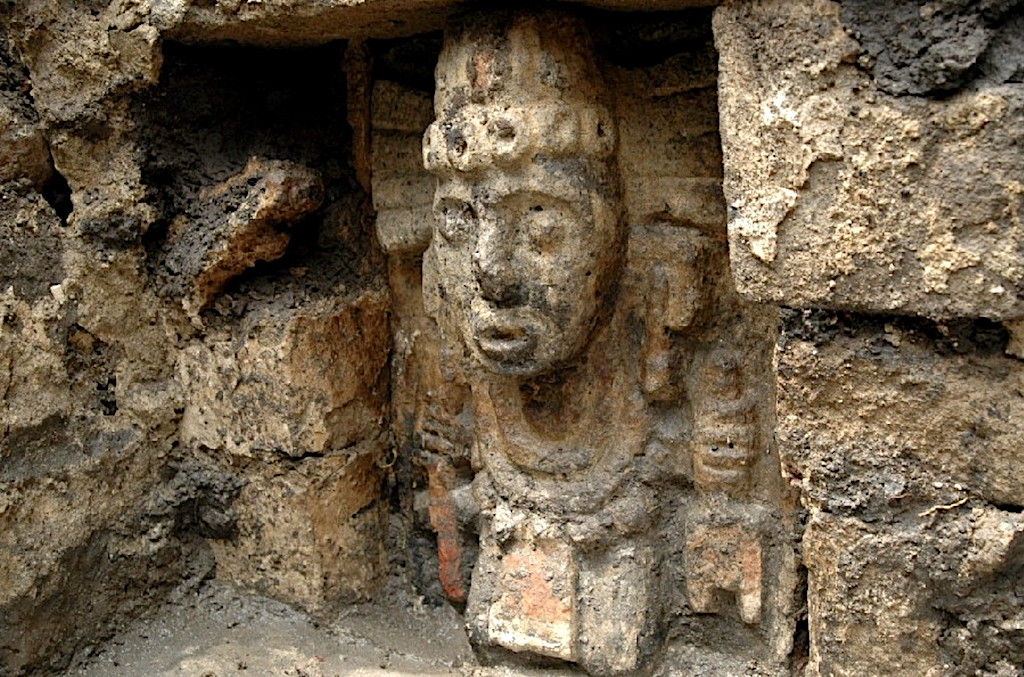(Mexico City) — In 1978, the discovery of the Coyolxauhqui Stone beneath Mexico City’s streets captivated the archaeological community, showcasing the artistic brilliance of the Aztec civilization. Nearly thirty years later, another groundbreaking find has come to light in the heart of the city at the revered Templo Mayor site—a massive stone altar, likely a sacred tribute to a powerful Aztec god.
This major discovery, which surfaced after six years of careful excavation on a neighboring property, highlights the ongoing interplay between Mexico’s deep historical roots and its modern identity. Under the layers of colonial architecture and the unending flow of contemporary life, the remains of Tenochtitlan—the ancient Aztec capital—persist, awaiting recognition. Each new archaeological layer reveals more of the empire’s lost legacy, demanding global attention.
Related → Teotihuacan: City of Water, City of Fire exhibition at Phoenix Art Museum
A city layered with time
Mexico’s Centro Histórico embodies a temporal paradox, where different eras coexist. Beneath the city’s historic streets and grand cathedral lies a submerged yet enduring civilization. Walking through this district means navigating both the modern metropolis and the ancient capital. It is widely understood that the remnants of a once-dominant empire lie beneath the symbols of Spanish colonization.
Archaeologists have been systematically uncovering this hidden world, revealing the architectural complexity of temples, platforms, and altars. The recently found monolith, dating to the reign of Moctezuma I (1440–1469), reflects the Aztecs’ profound religious fervor and artistic sophistication. Measuring around 11.48 by 13.12 feet and weighing more than 27,000 pounds, it bears images of Tlaloc, the rain deity, alongside a mysterious second figure—linking mythology with tangible history.
Discovery almost missed
This historic altar might have remained hidden if not for a twist of fate. In 2000, before its discovery, the city planned a municipal building at 38 República de Guatemala Street, formerly home to the Casa de las Ajaracas. Those plans changed when archaeologists found sacred offerings there—rare artifacts dedicated to Tlaloc, such as paper pouches, ceremonial garments, resin figures, and fabrics.
In 2006, after two carved serpent heads were found nearby during urban renovations, the Instituto Nacional de Antropología e Historia (INAH) confirmed a monumental find: an altar of exceptional spiritual and artistic value, buried under centuries of city life.
Enduring history in stone
The Spanish conquest of Tenochtitlan in 1521 aimed to erase the old ways, demolishing Templo Mayor’s sacred structures. But instead of total destruction, new colonial buildings rose over the ruins, preserving the past beneath them. Now, this newly exposed altar—possibly hidden by the Aztecs themselves to protect it from Spanish invaders—remains as a quiet act of resistance.
The rediscovery of this stone echoes the momentous 1978 uncovering of the Coyolxauhqui Stone, which launched modern exploration of Templo Mayor. Each artifact unearthed since has shed new light on Aztec religious life, enriching the field of Mesoamerican studies.
Rewriting history
This latest find reshapes what we know of Aztec civilization. Its importance transcends its size, offering a rare glimpse into a world where ritual, belief, and power intersected. It’s a powerful reminder of how sacrifice and stone forged an empire’s fate.
An enduring cultural inheritance
Mexico City has long stood atop the buried city of Tenochtitlan, quietly preserving its heritage. With every tremor, construction, and excavation, the ancient past reemerges. This altar’s return is more than a rediscovery—it’s a symbolic revival of a legacy that refuses to be silenced.
As digs continue, one question remains: What other secrets lie beneath the city, waiting for time and chance to bring them back into the light?
EXTERNAL LINK → Templo Mayor Museum
© 2006 - 2025, Eduardo Barraza. All rights reserved.





